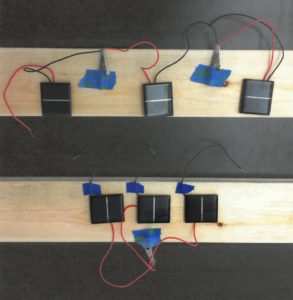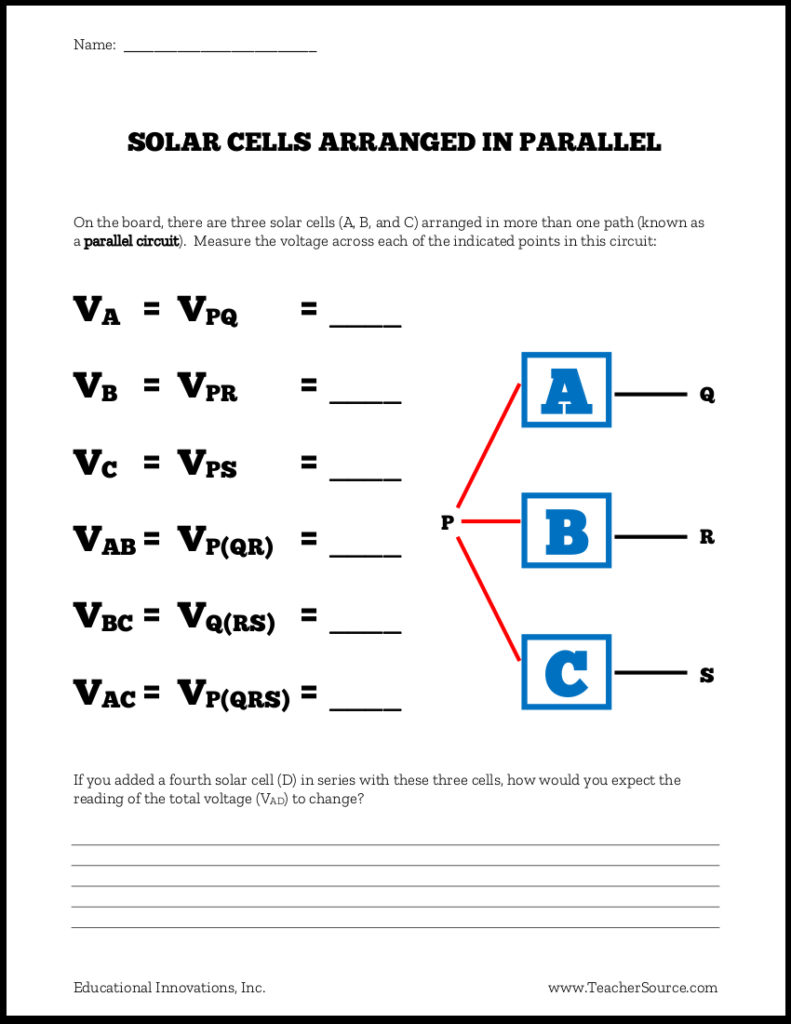 By Marty Mathiesen
By Marty Mathiesen
During the electricity unit in my high school physics class, I like to do an activity in which students determine the effect of having batteries placed in a series circuit and also in a parallel circuit. We explore questions such as What are the similarities? The differences? What are the advantages of each method? Do you see any patterns?
 Going Further with Series and Parallel Circuits
Going Further with Series and Parallel Circuits
I wondered how I could add something extra to these two activities. One day I realized that I could make good use of solar cells. This way, students would easily see the similarities and differences between conventional batteries and solar cells. Students could examine the use of each power source, identify some of their advantages and disadvantages, and identify situations where one source would be better than the other one.
 I set three solar cells on a board in series (using blue tape to hold them in place) and connected them with alligator clips.
I set three solar cells on a board in series (using blue tape to hold them in place) and connected them with alligator clips.
Using a voltmeter, my students now could measure the voltage produced by each solar cell, pairs of cells, and batteries. As a variable, I invited them to place the solar cell board in a darkened area to see what effect that might have.
Solar Cells Add So Many Variables!
Once they finished their explorations, I placed the three solar cells in a parallel circuit and repeated the whole process. Again, I encouraged my students to test different variables and compare the results to the battery arrangement.
Since different batteries sizes provided different results, I decided to introduce a variety of solar cell sizes into the mix (although the photo in this blog shows them all at the same size). By combining different cells, students could hopefully gain further insights. I also found that using alligator clips (taped down) made good contacts for the voltmeter probes.
Putting the cells on a board made it easier to move the whole system. We were able to transport the board to different parts of the classroom, bring it outside, change the board’s angle in comparison to the Sun’s rays, add additional cells, or remove some.
Solar Cell Worksheets
I created the worksheets below for my students. Click here or on the graphics for a PDF with both worksheets.
As a result of our exploration, my students were able to understand important concepts about electricity as well as solar energy. I believe this lab would be appropriate for students in grades 8-12. Enjoy!
Editor’s note: If you’re looking for other teaching ideas related to electricity and green energy, check out our ELECTRICITY NEWSLETTER and our GREEN SCIENCE NEWSLETTER.
You can also sign up to receive future newsletters here. You’ll receive our future newsletters automatically… and as a new subscriber, you’ll get $5 off your next purchase of $50 or more!
Marty Mathiesen is a high school Physics teacher in Santa Fe Christian Schools, Solana Beach, CA




